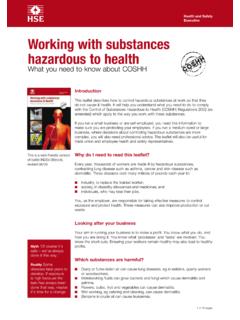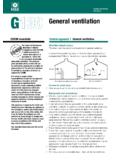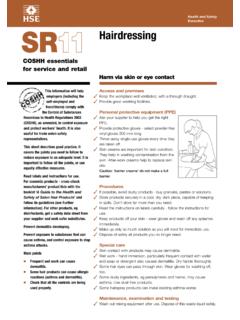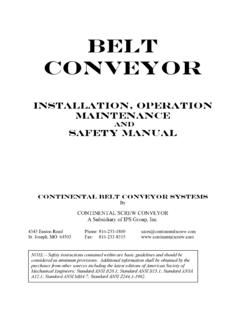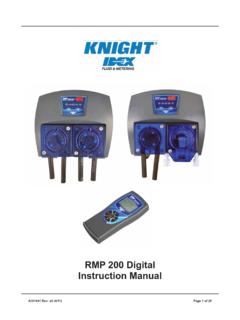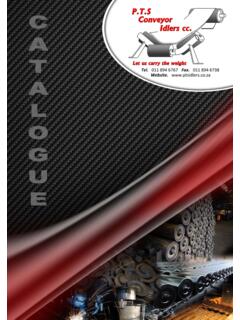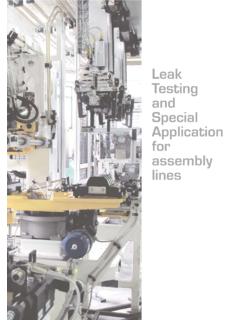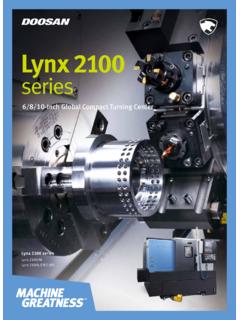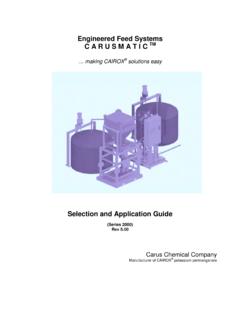Transcription of Health and Safety Executive G Conveyor transfer
1 Health and Safety Executive G Conveyor transfer COSHH essentials Control approach 2 Engineering control The Control of Substances What this sheet covers Hazardous to Health This sheet describes good control practice when carrying out Conveyor Regulations 2002 (COSHH) transfer . require employers to ensure that exposure is prevented or, where this It covers the key points you need to follow to reduce exposure to an is not reasonably practicable, adequate level. Follow all the points, or use equally effective measures. adequately controlled. This guidance gives practical advice on how this can be achieved by applying the principles of Minimise Exhaust Exhaust good practice for the control of exposure drop height Flexible curtain to substances hazardous to Health , as at feed required by COSHH. Air in Air in Air in It is aimed at people whose responsibilities include the management of substances hazardous to Health at work (eg occupational Health Scraper to clean specialists, anyone undertaking COSHH return belt assessments, supervisors and is also Minimise drop height at transfer useful for trade union and employee or discharge Safety representatives).
2 It will help you carry out COSHH assessments, review Access to work area existing assessments, deliver training and 3 Allow access to authorised and appropriately trained people only. supervise activities involving substances hazardous to Health . Equipment and procedures This guidance is issued by the Health and 3 Consider wetting to reduce the dustiness of the substance. Safety Executive . Following the guidance is 3 Enclose the belt as much as possible, and particularly at the feed and not compulsory, unless specifically stated, discharge points. and you are free to take other action. But if you do follow the guidance you will 3 Provide dust curtains at the open ends of the enclosures and skirting at normally be doing enough to comply with the sides of the belt. the law. Health and Safety inspectors seek 3 Provide local exhaust ventilation (LEV) at the feed chute and drop points.
3 To secure compliance with the law and 3 The inward airflow at all openings on the Conveyor or enclosure must may refer to this guidance. be sufficient to effectively capture any airborne contaminant. This will See Essential information near the end of depend on the design, size of opening and the type of substance being the sheet. controlled. 3 Provide Safety guards to prevent contact with moving parts of the Conveyor system. 3 Design the enclosure in sections to allow easy access for cleaning and maintenance. 3 Hinged doors should be provided for routine inspection tasks. 3 Provide as much space as possible within the enclosures. This will help contain the dust. 3 Position the feed chute so substance joins the centre of the belt, moving in the same direction and at the same speed as the belt. G205 Conveyor transfer 3 Minimise the height that the substance falls from the chute to the belt.
4 3 Fit a scraper to clean the return belt. 3 Use a similar approach for bucket elevators and screw conveyors. 3 Where possible, site the work area away from doors, windows and walkways, to stop draughts interfering with the LEV and spreading the airborne contaminant. 3 Have a clean air supply coming into the workroom to replace extracted air. 3 Provide an easy way of checking the LEV is working, eg airflow indicator or equivalent. 3 Discharge extracted air to a safe place away from doors, windows and air inlets. 3 With dusts you can re-circulate clean, filtered air into the workroom. 3 With vapours air re-circulation is not recommended. 3 Ensure all components are appropriate for the materials being captured, ie suitable for explosive, corrosive and flammable substances. Personal protective equipment (PPE). 3 Chemicals identified by COSHH Essentials as hazard group S can damage the skin and eyes, or enter the body through the skin and cause harm.
5 Check the Safety data sheets to see what PPE is needed. 3 Ask your supplier to advise on suitable protective equipment. 3 Make suitable arrangements for maintenance, storage and replacement of PPE. Personal decontamination 3 Provide warm water, mild skin cleansers, and soft paper or fabric towels for drying. Avoid abrasive cleansers. 3 Provide pre-work skin creams, which will make it easier to wash dirt from the skin. 3 Provide after-work creams to replace skin oils. Caution: Barrier creams' are not liquid gloves' and they do not provide a full barrier. Maintenance, examination and testing 3 Keep all equipment used for the task in effective working order. Maintain it as advised by the supplier or installer. 3 Check for signs of damage to control equipment before starting work. 3 Follow any special procedures before any systems are opened or entered, eg purging or cleaning.
6 Don't forget you may need personal protective equipment (PPE) for some maintenance tasks. 3 Visually check all equipment at least once a week for signs of damage or faults. 3 For LEV systems, a user manual or log book is helpful in setting out the frequency of checking, maintenance or parts replacement. 3 For LEV systems with no user manual or log book, you may need the help of a competent person. They can determine the performance needed for adequate control. 3 Keep records of all examinations for at least 5 years. 3 LEV systems require a statutory thorough examination and test' (TExT). 3 Get a competent person to perform the TExT at least every 14 months. 3 Carry out all actions arising from the TExT. 3 HSG258 provides more detailed information on LEV systems and legal and competence requirements. G205 Conveyor transfer 3 Several measures are available to check effectiveness of controls.
7 These range from simple qualitative (use of dust lamp) to complex quantitative techniques (eg air sampling) usually for higher risk scenarios. Cleaning and housekeeping 3 Clean work equipment and the work area daily. Clean other equipment and the workroom regularly at least once a week. 3 Vacuum dry dust or use wet cleaning methods. 3 Deal with spills immediately use suitable protective gloves. You may also need respiratory protective equipment (RPE). Caution: Never allow the use of brushes or compressed air for removing dust from skin and clothing. Avoid the use of brushes or compressed air for removing dust from surfaces or from inside machinery. Training and supervision 3 Provide supervision ensure that safe work procedures are followed. 3 Tell workers about the hazards associated with their work. 3 Provide workers with training on: n working safely with hazardous substances.
8 N when and how to use controls;. n how to check they are working;. n how the LEV system works;. n how to use the LEV to get the best out of it;. n how to check that the LEV is working; and n what to do if something goes wrong. 3 Consider keeping training records. 3 Changes to the work process and LEV means that staff might need retraining. 3 Have a procedure to check that control measures are in place and being followed. 3 Involve managers and supervisors in Health and Safety training. Essential information General storage of solids and liquids COSHH Guidance Sheet G101. HSE 2016 General advice on chemicals causing harm via skin or eye contact COSHH Guidance Sheet S100 HSE 2016. Selection of personal protective equipment COSHH Guidance Sheet S101. HSE 2016 Further information Clearing the air: A simple guide to buying and using local exhaust ventilation (LEV) Leaflet INDG408(rev1) HSE Books 2008.
9 Controlling airborne contaminants at work: A guide to local exhaust ventilation (LEV) HSG258 HSE Books 2011. G205 Conveyor transfer Local exhaust ventilation (LEV) workplace fume and dust extraction Employee checklist web page: Are you clear about the 0 You can find the full COSHH essentials series at procedures for doing the job? Check the room is well 0 Occupational Safety and Health Consultants Register ventilated, and any extraction or air supply is For information about Health and Safety , or to report inconsistencies or switched on and working inaccuracies in this guidance, visit You can view HSE properly. Check the airflow guidance online and order priced publications from the website. HSE priced indicator or equivalent. publications are also available from bookshops. Look for signs of leaks, 0 wear and damage before every job. If you find any problems, 0 tell your supervisor.
10 Don't just carry on working. Make sure the air 0 movement is across or away from your face. Wash hands before starting 0 the job, and before eating, drinking, smoking or using the lavatory. Don't use solvents to clean 0 your skin. Clear up spills immediately. 0 For liquids, contain or absorb spills with granules or mats. For solids, use vacuum or wet cleaning. Dispose of spills safely. 0 Use, maintain and 0 store any PPE provided in accordance with instructions. Crown copyright If you wish to reuse this information visit for details. First published 10/03. Published by the Health and Safety Executive 01/18. This document is available at.


